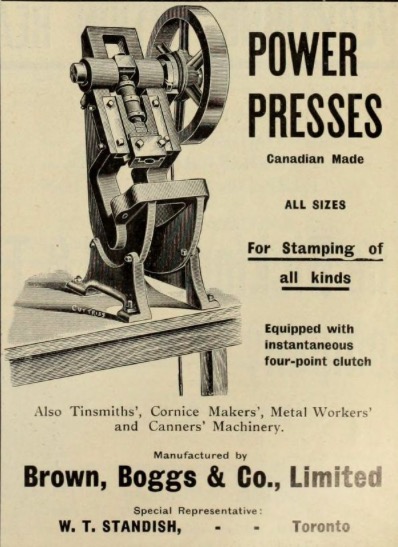Manufacturers Index - Brown, Boggs Co., Ltd.
Brown, Boggs Co., Ltd.
Hamilton, ON; Toronto, ON, Canada
Company Website: http://www.brownboggs.com/history.htm
Manufacturer Class:
Metal Working Machinery
Last Modified: Jul 12 2023 9:10AM by Jeff_Joslin
If you have information to add to this entry, please
contact the Site Historian.
|
In 1872 Samuel J. Moore, doing business as S. J. Moore, began making tinners' and canners' tools and machinery. That business was possibly descended in some way from Hamilton foundry and sheet metal maker Dennis Moore & Co. At some point S. J. Moore reorganized as S. J. Moore & Co., by which time the business had expanded to encompass a line of sheet metal machinery. In 1890 the business was acquired by John Mootry Brown, Nathan Glass Boggs, James Anderson, and Willard Ernest Blandford, and reorganized as Brown, Boggs Co., Ltd. Mr. Boggs had apprenticed at Moore, and both Boggs and Brown were journeymen there. We don't know anything about Anderson or Blandford. The company continued to specialize in manufacturing sheet metal machinery, and remains in business today, having moved to Ancaster and 1996 and then to Toronto in 2006.

Advertisement from March 1906 "Canadian Machinery"
Information Sources
- 1884 book Hamilton and Its Industries has a writeup on Dennis Moore & Co. that provides a history of this firm and its predecessors, dating back before 1832. Their foundry is illustrated. The book does not mention S. J. Moore, Brown, Boggs, Anderson or Blandford.
- 1885 Sessional Papers of the Dominion of Canada lists manufacturers, including S. J. Moore of Hamilton, making "Tinners' and canners' tools", established 1872.
- 1910-08-04 The Iron Trade Review
The death of Nathan G. Boggs, aged 55, president of the Brown & Boggs Co., Hamilton, Ont., manufacturers of tinsmiths' tools and machinery, took place at that city, July 22. Mr. Boggs began his business career with the firm of S. J. Moore & Co., and 23 years ago, in partnership with J. M. Brown, acquired the business which gradually developed into an important industry. He had been in ill-health for several years preceding his death.
- From the 1913-01-02 Canadian Machinery.
The Brown Boggs Co., Ltd., Hamilton, Ont.Among the many firms whom an increasing volume of business has compelled to extend their premises must be included the Brown, Boggs Co., who have of late greatly widened their field of operation. Always known as leading manufacturers of sheet metal working machinery of the highest class, they have lately gone in for heavier lines, such as heavy power presses and shears for similar work. They have also extended their line of canning machinery and are now employing a staff of draftsman on plans for the complete outfitting of the most modern canning plants, including the architectural work, power plant, mechanical equipment, etc.
The Brown, Boggs Co., Ltd., are also manufacturing under patents rights a large amount of special canning machinery, hitherto only procurable in the United States. They are also sole Canadian agents for some fourteen United States manufactures of canning machinery and supplies.
The present works at the corner of King William St. and Victoria Avenue are now entirely inadequate to the company's growing needs, and a thoroughly modern factory is under erection. This is situated on a fine site of 8 acres, on the west side of Sherman Ave., immediate north of G.T.R. tracks, to which it has a frontage of 935 feet. The site is also serviced by the C.P.R. and the T. H. & B. R.
The first unit, now rapidly approaching completion, consists of a pattern shop and storage, and a modern foundry. The pattern shop is an up-to-date 3-storey building with a reinforced concrete frame filled in with brick curtain walls. The ground and second floors will be used for pattern storage purposes, patternmakers being accommodated on the top floor. Large window areas, filled with steel sashes, provide ample natural light, and a very complete complete equipment of band saws, jointers and other necessary wood-working machinery will be installed.
The foundry is a steel frame building of thoroughly up-to-date design and will have electric traveling cranes, air-operated moulding machines, sand blast apparatus and other modern appliances. This foundry will give the company about four times their present output.
Later, it is proposed to enlarge the new plant by the addition of a machine shop, blacksmith shop, warehouse, offices and power house; and when these are completed the company's present works, covering an area of about 1½ acres, will be disposed of.
- Canadian industry, commerce, and finance; published as a companion volume to The Journal of Commerce, 1916, by J. J. Harpell: Lists Brown, Boggs Co., Ltd., Toronto, Ont., as a producer of drill presses; dies; fruit evaporators; foot and power presses for sheet metal stamping; punches and punch couplings; soldering irons; bench vises.
- Advertisement in the 1940 Canadian Trade Index for "Brown-Boggs Foundry & Machine Co. Limited". The ad lists power presses, shears, forming rolls, bending brakes, and tinners' tools. The ad has an inset that says, "Serving Canada's Metal Working Industry since 1879".
- 2007 book Craft Capitalism: Craftworkers and Early Industrialization in Hamilton, by Robert B. Kristofferson. "A number of examples suggest that the craft progression had at least some life well after the 1870s. Nathan Glass Boggs served an apprenticeship and worked as a journeyman for tinsmith's tools maker Samuel J. Moore before setting up his own highly successful tinsmith's tools business with fellow Moore journeyman John Mootry Brown in 1890." Elsewhere in the book it names the Hamilton manufacturers listed in the 1871 census, including founder and tin/sheet iron supplier Dennis Moore & Co.
- The Canada Science and Technology Museum has in its collection a can seamer (called by the museum a "grooving machine" made by S. J. Moore. They assign it a date range of 1867-1893.
- Directory of Metalworking Machinery, 1951, pgs. 8-10
|